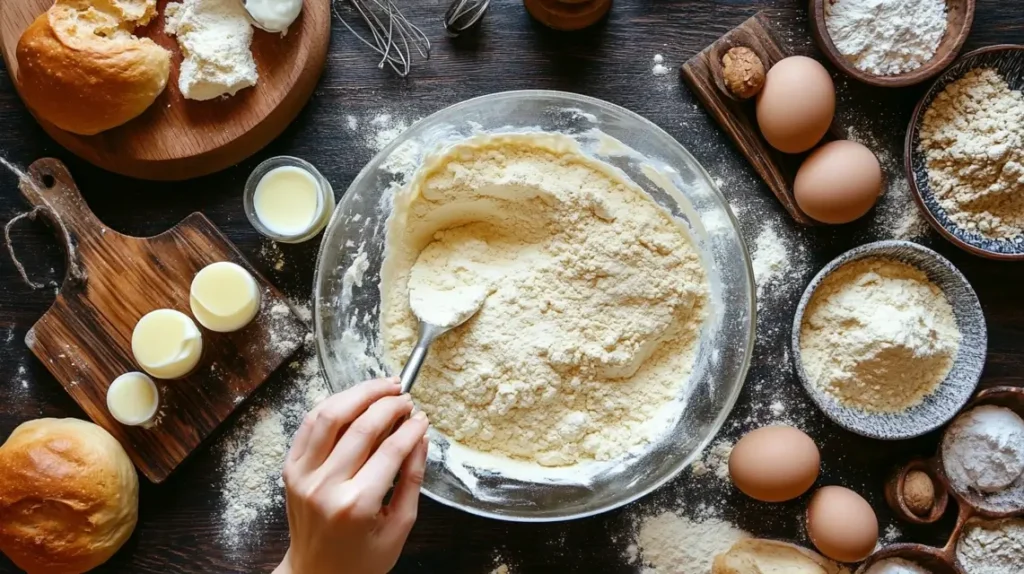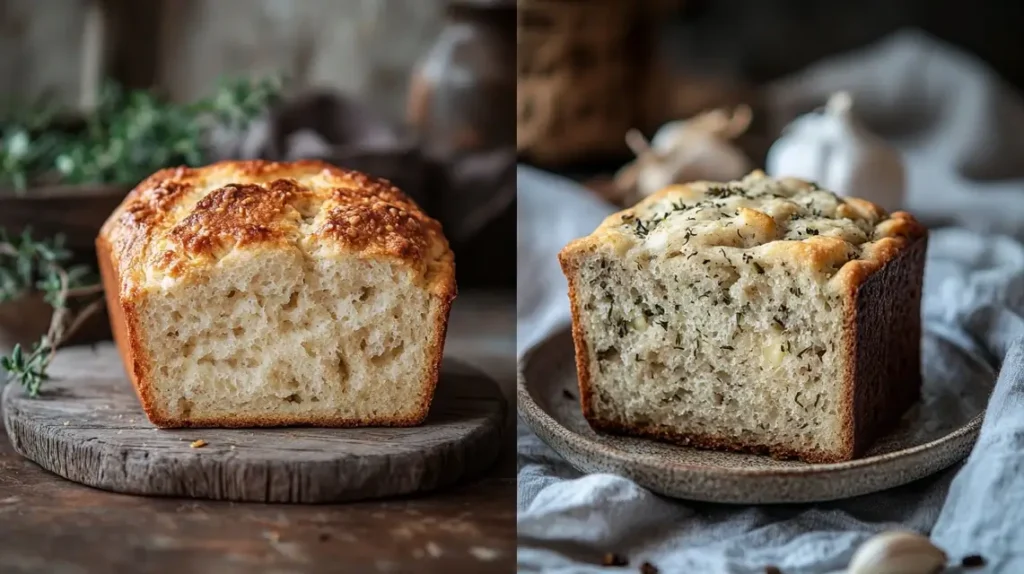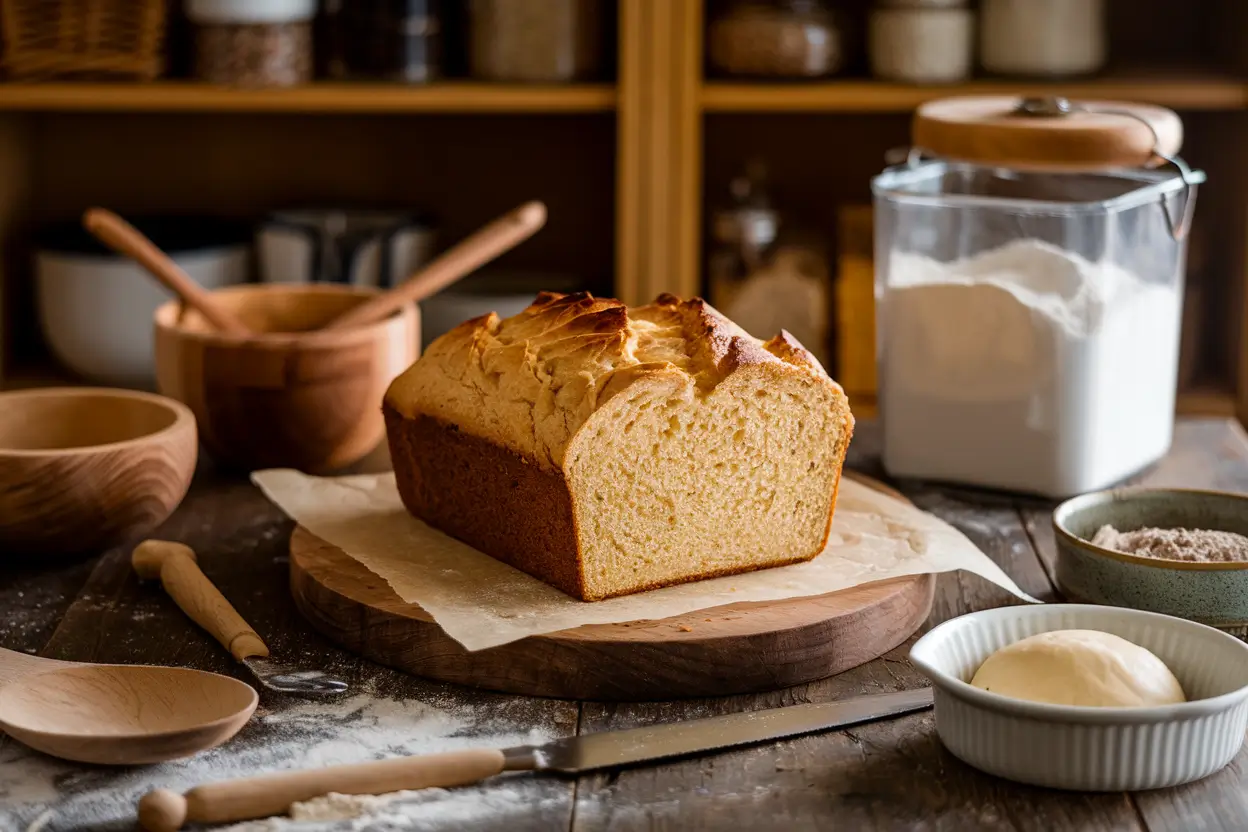Table of Contents
Introduction
Sourdough quick bread recipes are the perfect way to enjoy the tangy taste of sourdough without the wait. These quick bread recipes combine the bold, complex flavor of sourdough with the speed and simplicity of fast-rising loaves, making them ideal for busy bakers and beginners alike.
Unlike traditional sourdough, which requires hours of fermentation, sourdough quick bread skips the long proofing process. Instead, it uses baking powder or soda as a leavening agent to create a delicious loaf in under an hour. Whether you’re preparing for a family meal, breakfast, or a casual snack, sourdough quick bread recipes are as versatile as they are easy to make.
Before diving into these delicious sourdough quick bread recipes, you might be wondering: Is sourdough actually considered a quick bread? If you’re unsure about the key differences, check out our in-depth guide on Is Sourdough Considered a Quick Bread? to understand how sourdough and quick breads compare
The Unique Joy of Baking Quick Bread
Sourdough quick bread recipes offer a modern twist on traditional sourdough baking, making it accessible and enjoyable for everyone.
A Modern Twist on Sourdough
Traditional sourdough baking relies on yeast and wild bacteria to ferment the dough and create the iconic tangy flavor. This process can take hours or even days, requiring patience and planning.
Quick bread skips the yeast and uses chemical leavening agents like baking powder and soda, giving you a light, fluffy loaf without the wait. This shortcut is ideal for busy bakers who still want to enjoy homemade bread with the depth of sourdough flavor.
Why Everyone Loves Sourdough?
Sourdough has earned its place in kitchens worldwide thanks to its:
Versatility: From savory herb loaves to sweet cinnamon bread, the options are endless.
Rich Flavor: A tangy, complex taste that elevates any meal.
Health Benefits: Easier digestion and a lower glycemic index.
The Benefits of Making Sourdough Quick Bread Recipes
Sourdough quick bread offers more than just convenience—it’s packed with advantages that make it a favorite among home bakers. Here are some reasons why you should add sourdough quick bread recipes to your repertoire:
1. Faster Preparation Time
Traditional sourdough bread can take hours—or even days—because of the lengthy fermentation and proofing process. Sourdough quick bread eliminates the wait by using baking powder or soda for leavening, allowing you to enjoy fresh, tangy bread in under an hour.
2. No Yeast Required
Running low on yeast? No problem! Sourdough quick bread relies on your sourdough starter for flavor and chemical leavening agents (like baking soda or powder) to rise. This makes it perfect for times when yeast isn’t readily available.
3. Tangy, Complex Flavor
The sourdough starter brings a depth of flavor that’s hard to replicate with other quick bread recipes. Its natural fermentation process produces a subtle tanginess that elevates both sweet and savory loaves.
4. Digestive Benefits
Sourdough starters help break down gluten and starches, making the bread easier to digest than conventional quick bread. The fermentation process also creates prebiotics, which can promote gut health.
5. Endless Customization
Sourdough quick bread recipes are incredibly versatile. You can experiment with a variety of mix-ins, such as herbs, cheese, dried fruits, or chocolate chips, to suit your taste. Sweet or savory, simple or complex—the possibilities are endless!
6. Healthier Choice
Thanks to the natural acids in the sourdough starter, this type of bread has a lower glycemic index than many other quick breads. This means it causes less of a spike in blood sugar levels, making it a better option for those monitoring their carb intake.
7. Beginner-Friendly
Unlike traditional sourdough bread, which can intimidate new bakers with its precise timing and technique, sourdough quick bread is easy to make. The batter-like consistency is forgiving, so you don’t need to worry about kneading, shaping, or over-proofing.
8. Great Use for Extra Starter
If you maintain a sourdough starter, you’ll often have excess after feedings. Instead of discarding it, you can use it in sourdough quick bread recipes. It’s a sustainable and delicious way to minimize waste!
Your Guide to Key Ingredients of Sourdough Quick Bread Recipes

Making great sourdough quick bread starts with understanding the fundamentals of sourdough itself. If you want to take your baking to the next level, check out What Is the Secret to Good Sourdough Bread? for expert tips on achieving the perfect flavor, texture, and rise.
The success of sourdough quick bread recipes depends on the quality and balance of your ingredients.
Sourdough Starter: The Heart of the Recipe
The sourdough starter is what gives the bread its signature tangy flavor. It’s a mix of flour and water that ferments over time, creating natural yeast and bacteria. A well-fed, bubbly starter ensures your bread rises properly and tastes amazing.
- Tip: Feed your starter 4-8 hours before using it in a recipe to make it active and ready to work its magic.
Flour: Choose Your Base Wisely
The type of flour you use affects the texture and flavor of your bread:
- All-Purpose Flour: A versatile option that produces a light and fluffy loaf.
- Whole Wheat Flour: Adds a nutty, hearty flavor but creates a denser texture.
- Gluten-Free Blends: Ideal for those with dietary restrictions. Make sure to add xanthan gum for structure.
Add Flavor with Mix-Ins
Elevate your sourdough quick bread with creative mix-ins:
- Savory Options: Fresh herbs (like rosemary or thyme), minced garlic, shredded cheese, or sun-dried tomatoes.
- Sweet Options: Dried fruits (like raisins or cranberries), cinnamon, chocolate chips, or even a swirl of Nutella.
How to Bake the Perfect Loaf?
This foolproof recipe is perfect for beginners but leaves plenty of room for creativity.
Step 1: Prepare Your Ingredients
Here’s what you’ll need:
- 2 cups of flour (all-purpose or your choice)
- 1 cup of sourdough starter
- 1 tsp baking soda
- 1 tsp baking powder
- ¾ cup buttermilk (or milk with 1 tbsp vinegar)
- ½ tsp salt
Step 2: Follow the Recipe
- Preheat Your Oven: Set it to 375°F (190°C). Grease a loaf pan or line it with parchment paper.
- Mix Dry Ingredients: In a large mixing bowl, whisk together the flour, baking soda, baking powder, and salt.
- Incorporate Wet Ingredients: Add the sourdough starter and buttermilk to the dry mix. Stir gently until just combined—don’t overmix!
- Pour and Smooth: Transfer the batter to the prepared pan and smooth the top with a spatula.
- Bake: Place the pan in the oven and bake for 40-50 minutes. Check for doneness by inserting a toothpick into the center—it should come out clean.
- Cool Before Slicing: Let the bread cool completely to set its structure.
Solving Common Baking Problems
Even experienced bakers encounter hiccups, but most issues are easy to fix. Here’s how to troubleshoot common problems:
Dense or Heavy Loaves
If your bread turns out dense, it might be due to overmixing or expired leavening agents.
- Solution: Stir the batter gently and check the freshness of your baking powder and soda.
Flat or Uneven Bread
Uneven rising often happens when the batter isn’t spread evenly in the pan or when the oven temperature is inconsistent.
- Solution: Level the batter with a spatula and use an oven thermometer to ensure accuracy.
Overly Sour Flavor
A too-sour taste can result from an over-fermented starter.
- Solution: Use a freshly fed starter for a milder, more balanced flavor.
Delicious Variations to Try

The beauty of sourdough quick bread recipes lies in their versatility. Here are some exciting variations to inspire your next bake:
Herb and Garlic Bread
- Perfect For: Pairing with soups, stews, or pasta dishes.
- Ingredients: Fresh rosemary, thyme, minced garlic, and shredded Parmesan.
- Tip: Brush the top with melted butter and sprinkle with coarse sea salt for extra flavor.
Sweet Cinnamon Raisin Loaf
- Perfect For: Breakfast or dessert.
- Ingredients: Ground cinnamon, brown sugar, raisins, and a splash of vanilla extract.
- Serving Suggestion: Toast a slice and spread with butter or cream cheese.
Gluten-Free Sourdough Bread
- Perfect For: Those with dietary restrictions.
- Ingredients: Gluten-free flour blend, xanthan gum, and a splash of apple cider vinegar.
- Tip: Add seeds like chia or flax for extra texture and nutrition.
FAQs About Quick Bread and Sourdough:
What’s the Difference Between Quick Bread and Traditional Sourdough?
The main difference between quick bread and traditional sourdough lies in the leavening process. Quick bread relies on chemical leavening agents like baking powder or soda to make the bread rise rapidly. This eliminates the need for yeast or the long proofing times required in traditional sourdough recipes.
Traditional sourdough, on the other hand, depends on wild yeast and lactic acid bacteria naturally present in the sourdough starter to ferment and leaven the dough. This process is slow, often requiring hours or even days to achieve the desired rise and flavor.
The result? Quick bread is perfect when you’re short on time but still want tangy, flavorful bread, while traditional sourdough offers a chewy texture and complex flavors that come from extended fermentation. Both have their own charm, and sourdough quick bread recipes provide a convenient middle ground!
Can I Store Sourdough Quick Bread?
Yes! Proper storage is key to maintaining the freshness and flavor of your sourdough quick bread. Here’s how to do it:
- Room Temperature Storage:
- Wrap the loaf tightly in plastic wrap, foil, or place it in an airtight container to prevent it from drying out.
- Sourdough quick bread will stay fresh for up to 3 days when stored at room temperature in a cool, dry place. Avoid refrigeration, as it can dry out the bread faster.
- Freezing for Longer Storage:
- Slice the bread into individual portions before freezing. This allows you to thaw only what you need.
- Wrap each slice in plastic wrap and place them in a freezer-safe bag or container.
- The bread can last up to 3 months in the freezer. To reheat, simply thaw at room temperature or warm in the oven for a few minutes at 350°F (175°C).
- Reheating Tips:
- For best results, reheat slices in a toaster or oven. This helps restore the bread’s texture and flavor, making it taste freshly baked.
How Do I Make My Bread Less Sour?
If you find that your sourdough quick bread is too tangy for your taste, there are several ways to reduce the sourness:
- Feed Your Starter Before Baking:
- The longer your sourdough starter sits unfed, the more acidic it becomes, leading to a stronger sour flavor. To make your bread less sour, feed your starter 4-8 hours before baking. This ensures the starter is active and fresh, producing a milder flavor.
- Adjust the Fermentation Time:
- In traditional sourdough, a longer fermentation often intensifies the tang. For quick bread, this isn’t a factor since the leavening happens instantly. However, using an over-fermented starter can still increase sourness. Stick to a starter that has just doubled in size after feeding for a balanced taste.
- Balance Flavors with Sweet or Savory Additions:
- Incorporate ingredients that can counteract the tangy taste. For example, adding honey, maple syrup, or even cinnamon to sweet recipes can mellow out the acidity. Similarly, savory flavors like garlic, herbs, or cheese can mask the sourness.
- Experiment with Hydration Levels:
- A lower hydration starter (one with a thicker consistency) typically has less acidity. Adjust your starter feeding ratio to 1:1:1 (equal parts starter, flour, and water) instead of higher water content for a milder flavor.
By managing your starter and experimenting with flavors, you can customize the tanginess of your sourdough quick bread to suit your preferences.
Can I Make a Vegan Version?
Absolutely! Sourdough quick bread recipe is easy to adapt for a vegan diet, and the results are just as delicious. Here’s how to make the necessary substitutions:
- Replace Buttermilk:
- Instead of traditional buttermilk, use plant-based milk (like almond, soy, or oat milk) mixed with 1 tablespoon of vinegar or lemon juice. Let the mixture sit for 5-10 minutes to curdle slightly, mimicking the acidity and texture of buttermilk.
- Add Fat or Richness:
- If the recipe calls for butter, swap it out for plant-based butter or neutral oils like coconut or vegetable oil. These options ensure the bread remains moist and flavorful.
- Skip Eggs:
- Most sourdough quick bread recipes don’t require eggs, but if they do, you can substitute with a flaxseed or chia seed “egg.” Mix 1 tablespoon of ground flax or chia seeds with 3 tablespoons of water, let it sit for 5 minutes, and use it as a replacement.
With these substitutions, you can create a vegan-friendly loaf that’s just as tangy, soft, and satisfying as the original. Vegan sourdough quick bread is a great option for anyone with dietary restrictions or looking to bake with plant-based ingredients.
Conclusion
Sourdough quick bread recipes are the perfect fusion of bold flavor, convenience, and endless creativity. Unlike traditional sourdough that requires patience and long fermentation times, these quick bread variations allow you to enjoy the signature tangy taste in a fraction of the time. Whether you’re craving a hearty, savory loaf to complement a cozy dinner or a slightly sweet, spiced treat for breakfast, sourdough quick bread offers a versatile baking experience that suits every occasion.
With countless mix-in possibilities—from fragrant herbs and sharp cheeses to warm cinnamon and juicy raisins—you can tailor each loaf to your personal preferences. Plus, using your sourdough starter in quick bread recipes is a fantastic way to reduce food waste while still enjoying all the benefits of homemade baking.
So why wait? Grab your starter, gather your ingredients, and step into the kitchen to create something truly delicious. Whether you’re a seasoned baker or a complete beginner, sourdough quick bread is a fun and rewarding way to bring homemade goodness to your table.
Happy baking! 🍞✨

